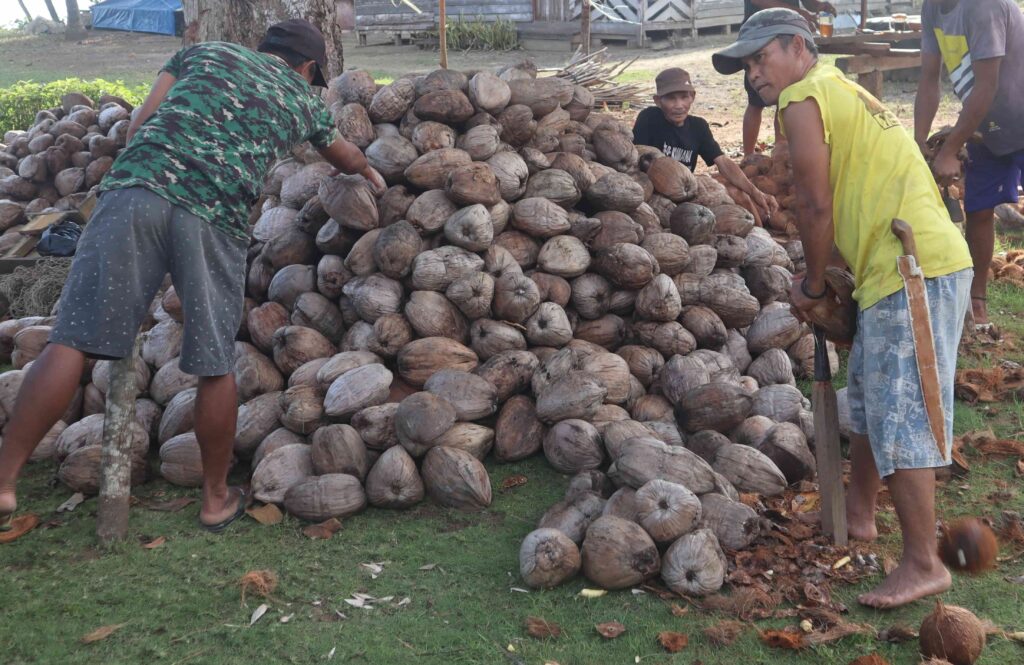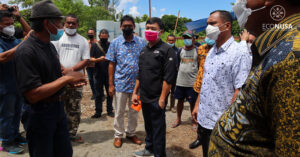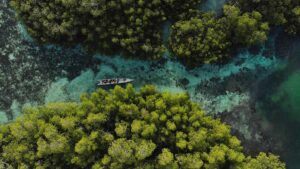
The Food and Agriculture Organization of the United Nations records that Indonesia is the world’s largest coconut producer with an average production of 18.04 million tons of coconuts. According to data from the Indonesia Agricultural Quarantine Agency there are 13 coconut derivative commodities marketed globally, including copra, which is dried coconut flesh.
Recognizing the potential of coconuts in Adijaya Village in Kaimana, West Papua, EcoNusa initiated the white copra cultivation training since early 2023. White copra is produced from coconuts that are dried using a solar dryer dome and sulfur.
The use of the drying dome accelerates the coconut drying process compared to traditional methods such as smoking or direct sun drying. White copra dried using this method has a lower moisture content and a cleaner, whiter appearance. Drying with a drying dome also prevents copra from being contaminated by dirt, fungi, and other harmful substances to human health.
Read Also: Dispersing Premium Nutmeg, An Agroforestry Spices Cultivated by Local Farmers in Maluku Islands
Sulfur is used to prevent the growth of fungi and enhance the quality of copra. These factors contribute to the higher market price of white copra compared to black copra.
White copra is typically used by industrial producers in the manufacturing of cooking oil, margarine, cosmetics, soap, moisturizers, perfumes, chocolate mixtures, ice cream, pharmaceuticals, and various other industries.
As the follow up from the socialization forums in early 2023, plans to construct four drying domes in Adijaya were initiated. Unfortunately, the dome’s constructions were hindered due to the wind season, which brought high waves, strong winds, and significant rainfall. Luckily, the season has come to an end. In September 2023, the drying domes, made with wooden frames and UV plastic covers, were successfully installed.
Read Also: Vanilla, A Source Hope for Improving Communities Income
Shortly after the drying domes were erected, 56 local farmers gathered to receive training on copra production, which was facilitated by Thamrin Lamuasa. 10 of the participants had prior experience as black copra farmers, while the rest worked in a chocolate company but have been wanted to produce copra as the additional source of income.
The first day of the training, farmers were taught to do coconut husking, splitting, washing, arranging the coconuts on the drying dome racks, and sulfur fumigation. Proper drying is crucial to prevent the copra from being susceptible to microbial contamination. On the second day of training, all participants practiced proper storage of the dried copra. Adequate storage is essential to prevent spoilage and maintain quality.
All participants were directly involved in the process producing white copra. The coconuts they had dried inside the drying domes were removed from their shells after 12 days of drying. They have successfully produced high-quality white copra. As a result, white copra from local farmers in Adijawa were shipped to the EcoNusa team in Ambon for quality checking and market assistance.
Read Also: Mama Yulita Turns Shrimp Heads Waste into Economic Value Products
Mr. Thamrin, the facilitator, mentioned that the quality check is conducted to assess the moisture content in the laboratory. If the drying process has been successful, the next step is to establish a marketing system, both locally and nationally. These processes aim to spread white copra cultivation practices to other villages and boost the coconut farmers’ economy in Kaimana and its surroundings.
Safianus Tanggulangan, one of the black copra farmers who participated in this training, shared that the white copra training presents an opportunity for the community to improve their economy during an uncertain market period for black copra. He also shared his hope on effective white copra marketing, bringing benefits to the community.
Following the training, some farmers committed to building their own drying domes, while others committed to initiating white copra production using the existing drying domes. Hopefully, these collective efforts by the local and indigenous communities will enhance their well-being.
Editor: Nur Alfiyah, Swiny Adestika







